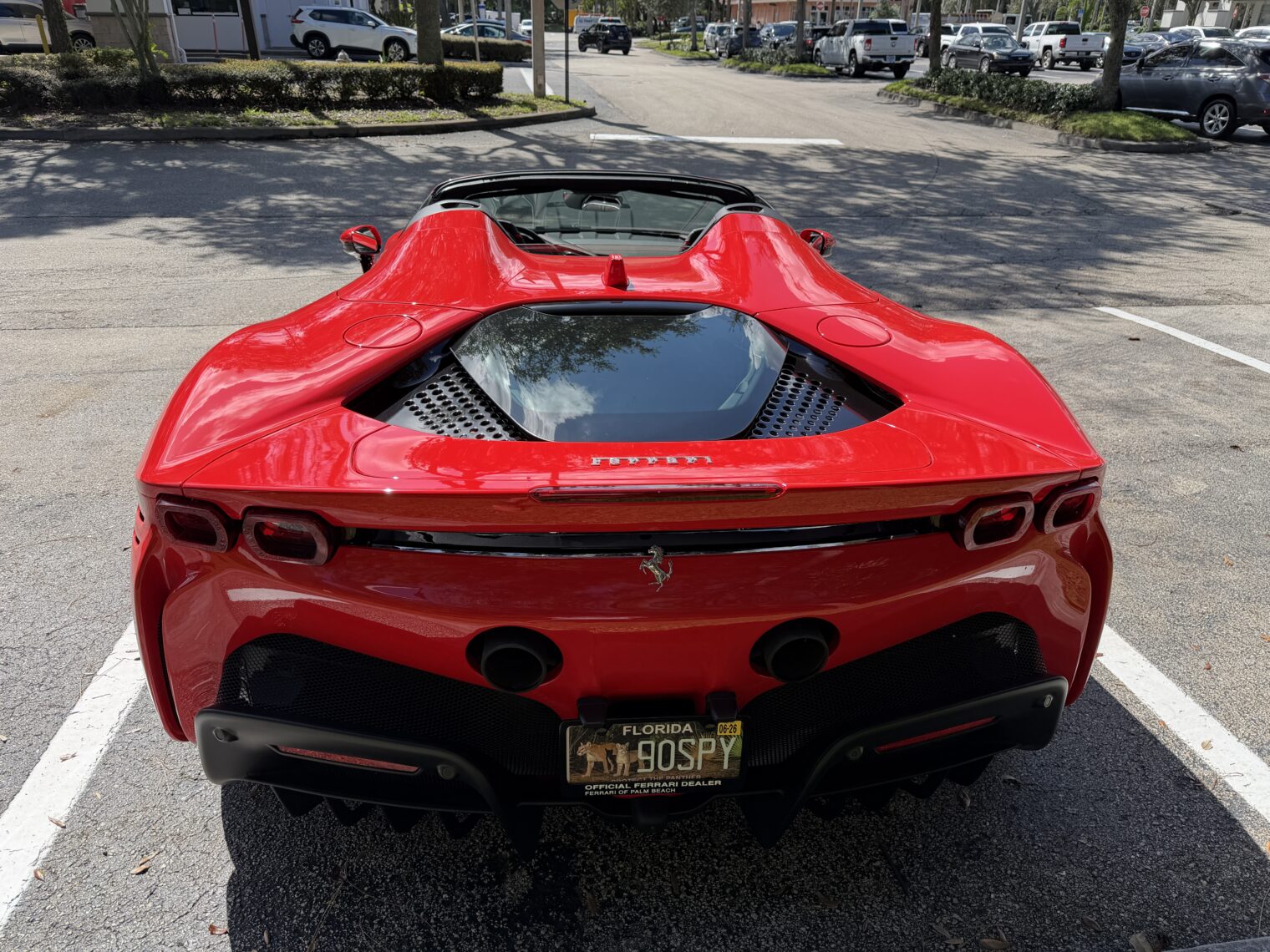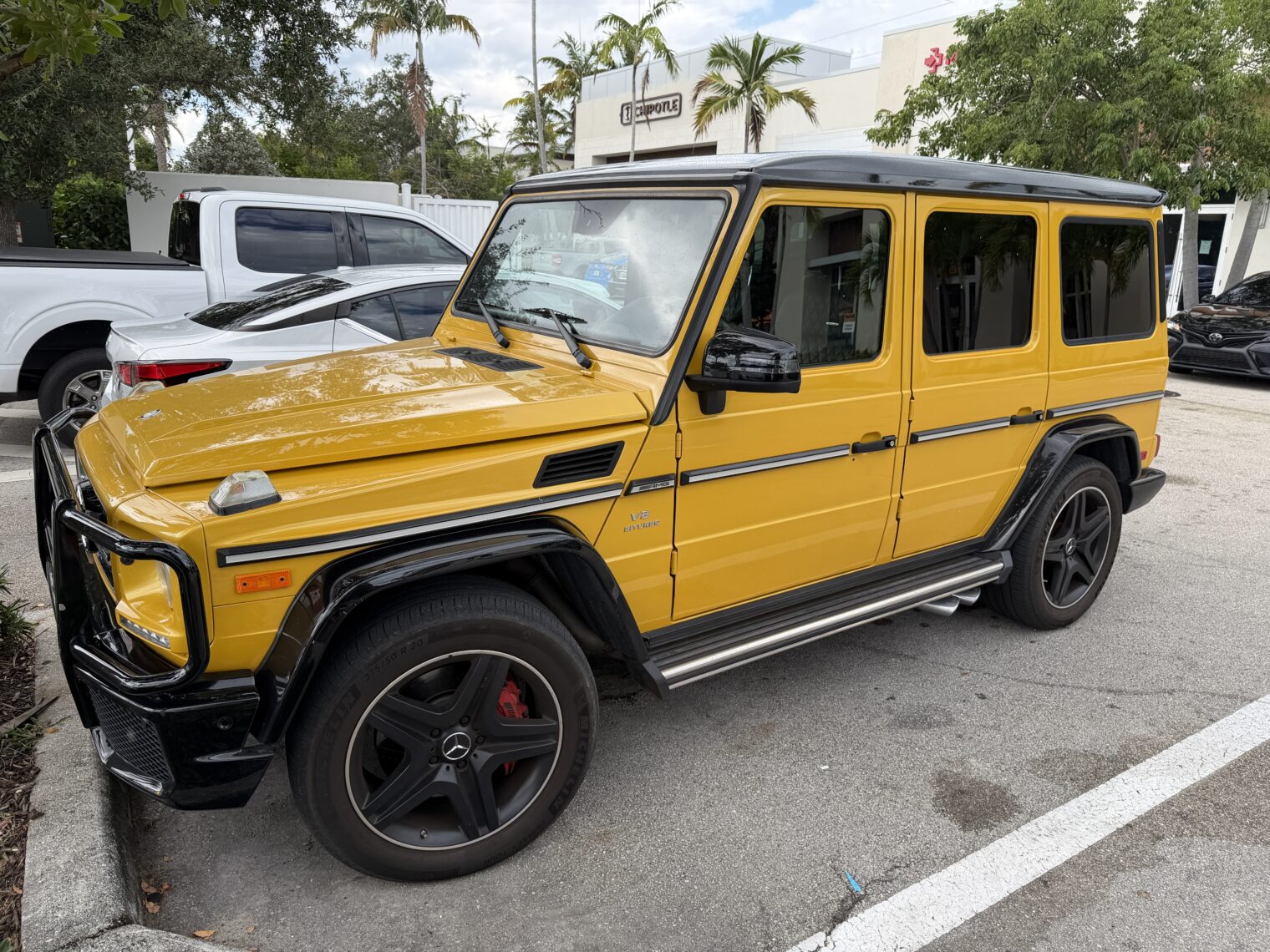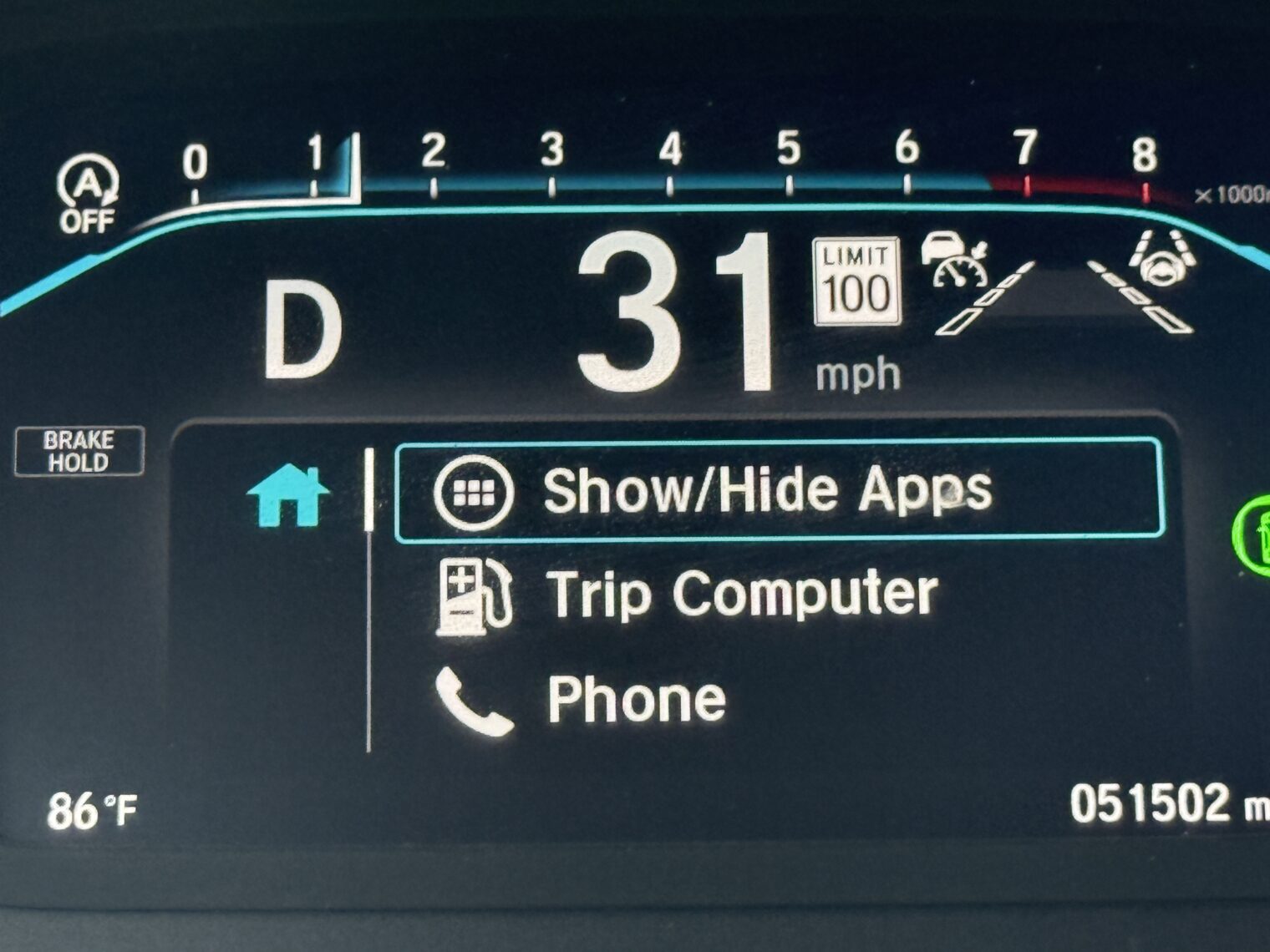Let’s check in with minivans for 2026 as it is long past time for us to retire our faithful 2021 Odyssey. For readers who worship at the Church of the Sliding Doors I will be grateful to get your advice. Nearly all of the driving will happen in Florida, a state with average gasoline prices (about $3/gallon most of the time in recent years). We expect to drive 10,000 miles per year and, therefore, would burn up $1500/year of gasoline at 20 mpg. Unlimited electric car charging at home is $31/month from Florida Power and Light, but it would be a bit cumbersome because we don’t park our minivan in the garage.
2026 Honda Odyssey: Exactly the same as the 2025 Honda Odyssey, which was almost exactly the same as the 2018 Honda Odyssey. Honda imposed a slight price increase in nominal dollars, which might translate to a slight price reduction in real dollars (adjusted for inflation). If Greta Thunberg hadn’t switched to pro-Hamas advocacy she would shed tears for the continued lack of a hybrid powertrain (admittedly the Toyota Sienna’s feels strained; see Toyota Sienna vs Honda Odyssey).
2026 Toyota Sienna: Would be tough to distinguish from the 2020 original. No improvements for 2026. Not as sporty or nimble as the Odyssey, but the dark green color matches much of the foliage in our neighborhood nicely and the optional captain’s chairs in the middle row would likely appeal to our spoiled kids (reduces seating capacity from 8 to 7). Hybrid powertrain approved by pre-Hamas-Edition-Greta Thunberg. Like seafaring blockade-running Greta, the Sienna isn’t afraid of danger. It comes with Toyota Safety Sense 2.0, an obsolete suite of feeble tech assistance from 2018. TSS 2.0 was superseded by TSS 2.5 (2021 Camry) and then by TSS 3.0 (2023 Corolla; 2025 Camry), but Sienna buyers are doomed to live in 2018.
2026 Chrysler Pacifica: Maybe the oldest platform in the group, dating to the 2017 model year? Zero improvements for 2026. The only plug-in hybrid minivan.
2026 Kia Carnival: minimal changes to this supposedly great 2020 minivan that is styled like an SUV (why not just get a Chevy Tahoe if the SUV image is desired?).
A heartbreaking time, in other words, for those of us who appreciate the genius of Lee Iacocca (first-generation Chrysler minivan below, introduced for 1984):
The Nazi-free all-electric minivan introduced to the U.S. in 2025 turned out to be an epic failure. “How Volkswagen’s Electric Bus Went From American Flagship to Flop” (WSJ):
The German auto giant was bringing back the bus as an electric vehicle, albeit one with a boxy design and two-tone paint job reminiscent of the original. The reboot was more than two decades in the making, and the company said the vehicle would soon be available in the U.S.
In the 1960s, the bus and the Beetle helped Volkswagen enjoy rapid growth. U.S. sales peaked at almost 570,000 in 1970, more than a third of the brand’s global total. At the time, the van was priced at the equivalent of around $20,000, less expensive than most cars.
With a battery range of less than 250 miles per charge, the ID.Buzz doesn’t compare favorably with other new EVs. The German-led design also failed to account for some uniquely American tastes: It often needs to be fitted with extra cupholders at U.S. ports.
The commercial-vehicle business is also based at a plant in Hanover that is among the company’s most expensive. The labor cost of producing a vehicle in Germany was roughly $3,307 last year, compared with $1,341 in the U.S., according to a recent report by consultants at Oliver Wyman.
When Diess showed an ID.Buzz prototype in 2017, he promised EVs that would be “affordable for millions, not just to millionaires.” The company prepared its Hanover factory to produce up to 130,000 units a year, and executives hinted that they could in time manufacture it in the U.S. as well.
Only around 30,000 units were sold last year, hurt in Europe by key markets including Germany and Sweden rolling back EV subsidies.
In April, the National Highway Traffic Safety Administration warned that the vehicle showed the international brake-warning sign in amber rather than the word “brake” in red capital letters, which is the requirement in the U.S. A few weeks later, the body said the third-row seat was too wide because it could accommodate three people even though it only had two seat belts. The company is fitting plastic parts to cover the sides of the seats in the roughly 5,600 vehicles affected.
Floridians love exotic new cars and yet I’ve seen only a handful of ID. Buzz minivans in the wild down here. One mom at a school event said that she loved hers, but noted that the range was short (officially 230 miles; Car and Driver highway test: 190 miles) and access to Tesla superchargers was “coming soon”. The exterior was snazzy while the interior looked like it had recently been the site of a birthday party, with lots of cake and snacks, for 17 preschoolers.
For those who can stomach the Nazi heritage, a Tesla minivan with FSD could be awesome!
(Is Tesla currently suffering from Osborne effect? They told all of their customers 1.5 years ago that HW4 is too feeble for self-driving and that HW5 has 5X the mental power (i.e., HW5 is like a Democrat from California with a Gender Science degree while HW4 is like a Red State HVAC tech) and that HW4 cars can’t be upgraded to HW5. Tesla said in June 2024 that HW5 would be delivered to consumers in January 2026, but now it looks like HW5 will show up in 2027.)
I hate to keep driving our venerable 2021 Odyssey with over 50,000 miles on the odometer, but I can’t see the value in switching to any of the above. People in Florida are careful about opening their doors so we have no door dings. Florida curbs are lovingly molded from concrete instead of being made from rough-hewn granite as in Maskachusetts. Therefore, we have no wheel rash. Since we don’t garage the car, however, I fear that the sun is taking its toll on the paint and interior and soon we will be getting notes from the G-Wagon-owning neighbors asking if we’re in financial distress. A few photos from the local strip malls just in the last week (an alien might infer from our parking lots that humans come in radically different sizes, which is why some can get around in small toys such as the Lambo while others need massive SUVs and pickup trucks):




One funny thing about our current Odyssey that I would miss: on a two-lane local road, it reads a sign about the Brightline train potentially exceeding 100 mph as a “speed limit is 100 mph” indication.



Dr. Greenspun, why wouldn’t you keep your current minivan and retire it once you have put 150-200k miles on it? 50k miles is not that much.
I’ve certainly driven cars into the ground before, e.g., an ungaraged Sienna in Maskachusetts for 9 years. I remember, though, that “driving shabby” didn’t save a lot of money because the depreciation every year was fairly constant. There was also an Infiniti that suffered a cam sensor failure on the Mass Pike while Senior Management was driving it. 110,000 miles and completely stuck due to the failure of a $1 part (cost over $1,000 to dig into the engine and replace, I think, not to mention towing). Maybe it costs $1,000/year extra, when one factors in maintenance events, to drive an almost-new car? AAA says that the average annual cost of car ownership in the inflation-free U.S. is about $12,000/year. So the cost of being in a new-ish car isn’t that high. Maybe these crazy new destination fees ($1500-2000) for new cars change the economics? You don’t get those back when trade a car in! Also, the dealers are now starting to charge $1000 “doc fees” that are pure profit. My calculation of the $1,000/year bump was done in pre-Biden times when dealers sold cars at invoice and didn’t get rich enough to buy jets (met a lot of new jet owners at Oshkosh this year, a plurality of them were car dealers who got rich during coronapanic).
It must be the poverty-stricken, “Barely worth 4 million dollars” kid from the tripledecker side of town who still lurking within me, but for the life of me I don’t know why you need to replace the Odyssey which drives like a car and is barely broken in at 50,000 miles with anything. Its not like the stove; it still works and you can get parts. Are the neighbors pointing at you and snickering?
As noted in my response to Anon, above, when I last did a calculation (pre-Biden), driving a car into the ground didn’t save significant money compared to the overall cost of car ownership. The main cost of being in a new car was the time spent in the annoying dealer sales process! Now that Americans decided to make every car dealer a billionaire maybe the financial analysis I did pre-Biden isn’t applicable.
https://cars.usnews.com/cars-trucks/best-car-deals/car-lease-deals shows that a lot of cars can be leased for about $400/month (the monthly fee plus the amortized initial payment). That’s $5000/year. The underlying car would be a stripped model of some sort maybe buyable for $30,000? If you kept it for 8 years and sold it for $5,000 it would cost $3135/year in depreciation. Let’s assume the finance value of the lease is $1000/year (3% interest rate). The older car will cost an extra $500/year at least in maintenance over its 8-year life (the lease car will stay under warranty and not need that many maintenance items either). So actually the difference in cost is closer to $500/year (leasing new every 3 years vs. buy and hold for 8 years).
Philip, what is your savings calculation in buying new Hondas every few years? Do you save on maintenance intervals, ie maintain new car once 10,000 miles vs once 5,000 miles and then trading it in almost new? Not changing break pads? Not having to change tires and allign weels? I am asking because I had driven over 700 000 miles in Hondas and had to bring them in only for maintenance or accident-related repairs. And I have never yet driven Honda into the ground either.
Ever year current year model adds at least $1,000 (now more) in inflation fees, and every year perfectly driven car looses at least $2,000 in post – maintenance value. Depreciation stops when car parts value exceeds into driving value and depreciation rate slows with time. You probably save on large service item every 100,000 to 150,000 miles or so but they usually not as expensive as one year depreciation costs.
Evaluating whether I need to change my car ownership strategy.
Anon: The biggest part of the calculation is realizing that the car continues to depreciate in years 3-10. Since the car is paid for it is easy to forget that the depreciation clock is still running. Just as freedom isn’t free, driving a paid-for car from Year 4 of its life into Year 7 of its life isn’t free. https://www.iseecars.com/car/honda-accord-hybrid/resale-value has some numbers. They say that a car has lost about 30% of its value after 3 years and then loses another 20% or so over the next 3 years. I.e., the car goes from losing 10%/year to losing 7%/year. But the extra maintenance costs might be 2%/year compared to the in-warranty car that is less than 3 years old.
What do you consider maintenance? For Hondas they I have or had owned, maintenance was 1) oil change – every 5 K miles, oil filter change -every 10 – 15 K miles – very cheap cost, same as for brand new car 2) breaks pad changes – every 25 K miles or so, key is make them on time so breaks themselves will not have to be changed which could bring maintenance to few hundred dollars at most, tire changes – every 60 K miles 3) cabin filter change, transmission liquid flash, different engine service items – used to be every 100,000 miles, no more like every 200,000 miles. All together can add up to 1/2 3/4 of annual depreciation of new vehicle. I usually do them if I think I will run my vehicle for at least another 2 years. 4) Body work and part replacements resulting from fender – benders – cheaper than for a new car as no new parts required by insurance. Have never had any other failure – related maintenance for Hondas in decades that I was driving them, unlike for Fords, GMs, and even Toyotas. Staying away from Nissan/Infinity world.
Do not see how you are saving money if you are buying new Honda every 3 years, you agree that Honda depreciation rate drops as Honda gets older.
I understand that saving $5,000 every three years by not having to pay large depreciation as often is not critical or important for you but do not call it money saving. If you keep Honda 10 – 15 years instead of 3 – 5 you are bound to save a good chunk of cash, $10,000 +, which you can put into risky investing with large upside if you do not care about the money anyway.
Thanks for the analysis. I think we are in agreement! You say that one can save $10,000 over 10-15 years and I said that the marginal cost of driving a new car is about $1,000 per year. The question then becomes is it worth $1,000 to gaze upon shiny paint every morning?
I wonder how the salty air in Jupiter affects the lifespan of the cars, do they rust out much, much faster? Honda has a 5 year/60K miles corrosion warranty, apparently. Otherwise, you used to be able to get 200K miles easily out of a well maintained Honda. It’s nice to have a shiny new car every few years, but that is an expensive way to get from point A to point B over time, even if you don’t finance it. I suppose the equation is changing with all the e-junk “features”, which even in Honda break–$1500 touch screens, yikes.
I wish I could buy from a dealer the exact same 25 year-old vehicle I own with 190K when it finally craps out. It doesn’t even have 1 screen to break or distract me, if you don’t count a tiny LCD stereo display as a screen. Cars would be better if they were simpler, focused on fundamental ergonomics, and equipped with non-distracted drivers instead of relying on fancy electronics. I’m a dinosaur, though, what do I know? 🦜
PP: I have seen a lot of rusted-out cars… in Maskachusetts, Maine, New Hampshire, and Connecticut. Salt on the roads, in other words, is far worse for a car than some salt in the air. Maybe if we parked our car on the street right at the beach it would be an issue, but 3 miles inland is apparently sufficient to avoid any ocean-induced corrosion.
I, for one, not upgrading my 2018 and 2019 Teslas with HW3 waiting for HW5. It would be ridiculous to upgrade to HW4 obsolete in a year (although I have to admit HW4 fsds much better than HW3). Teslas don’t have any resale value left in them anyway, so waiting a bit more doesn’t make a difference.
Anyway, I’ll join the voices, it’s a Honda, drive it to 100k+, wait for next gen to ship before upgrading.